|
Monday, October 17, 2011
Progress Notes
I had opportunity to talk with Jimmy Joe Myers the other day at the Red Oak Inn in Tuscumbia; one of the topics discussed was the future of the Ulman Post Office (photo 01).
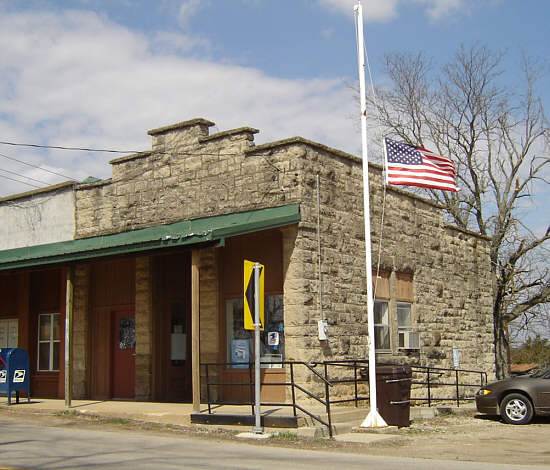
01 Ulman Post Office
Jimmy Joe said the prospects of keeping it weren’t good because of the cutbacks in funding for the U.S. Postal Service. The history of the Post Office in Miller County began December 21, 1837 in Tuscumbia when James Pryor Harrison became the first postmaster at his small log cabin store on the bank of the Osage River next to Shut In Branch Creek. Mail was delivered on horseback from Waynesville to Jefferson City via Tuscumbia. By 1842, people could receive mail once a week. In 1850 Miller County had four post offices: Iberia, Tuscumbia, Pleasant Mount and Rocky Mount. By 1860, post offices were located at Iberia, Tuscumbia, Ulman’s Ridge (Ulman), Pleasant Farm, Mt. Pleasant, Rocky Mount, and Fairplay (on the Osage River). As time went on a total of fifty five post offices at different locations throughout the county were established. Most of these are gone now as you can determine by this list from our website (photo 02).
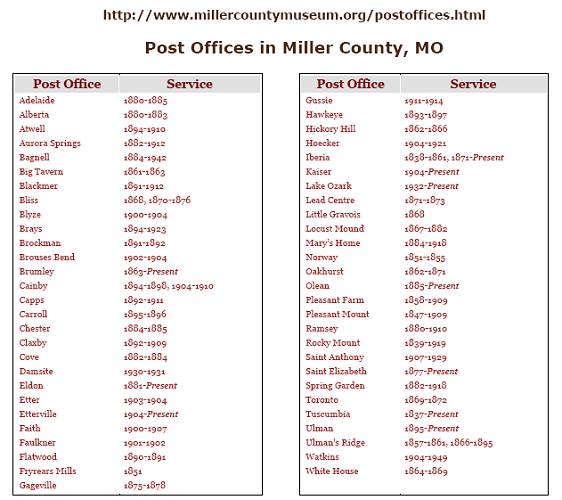
02 Post Offices in Miller County
Click image to view larger image in PDF format
Early on, post offices were established in stores or even homes and many times were not a stand alone operation.
An example of one of these was the post office established at the store in the Watkins community in 1904 owned by James Bowlin Watkins, son of William Shelton and Mary Jane Livingston Watkins. The post office stayed there until 1949 when it finally closed. The store itself closed in the early 1950’s (photo 03).
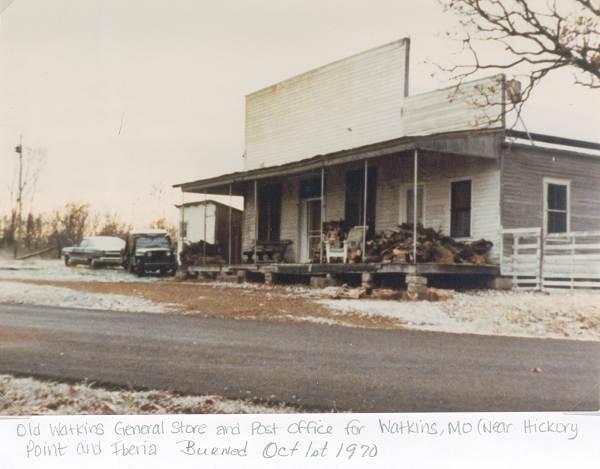
03 Watkins General Store and Post Office
The story of the Watkins community, the Watkins family and in particular that of William Shelton Watkins and the mystery of where his gold was hidden is very interesting and worth reading on our website.
We have in our museum the original spinning wheel used by Mary Jane Livingston Watkins, wife of William, donated by the family (photo 04).
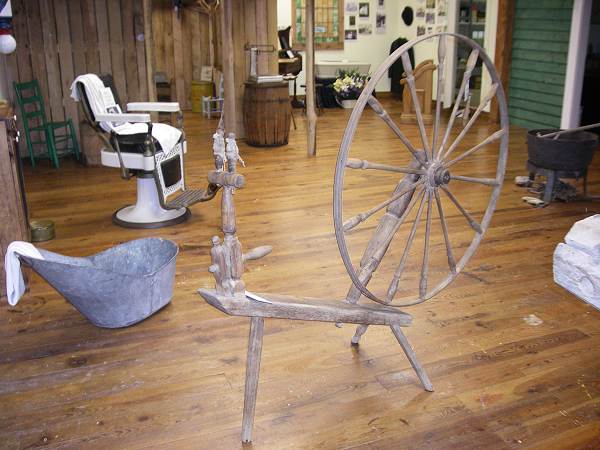
04 Mary Jane Livingston Watkins Spinning Wheel: 1833-1909
For those who are interested here is an abbreviated family history of the Watkins family researched by our museum director, Nancy Thompson (photo 05).
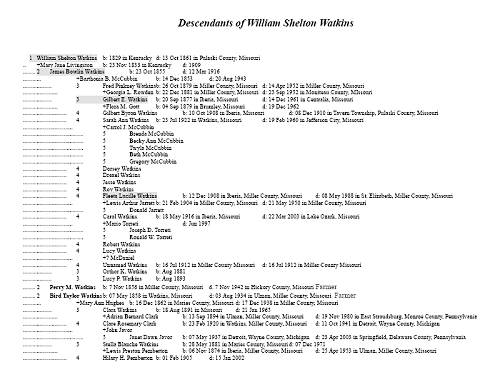
05 William Shelton Watkins Genealogy
Click image to view entire document in PDF format
One thing I found of interest in the family tree is that Carrol McCubbin, former county superintendent of schools as well as a former state legislator, was married to Sarah Ann Watkins, great granddaughter of William Shelton Watkins. She passed away several years ago (photo 06).
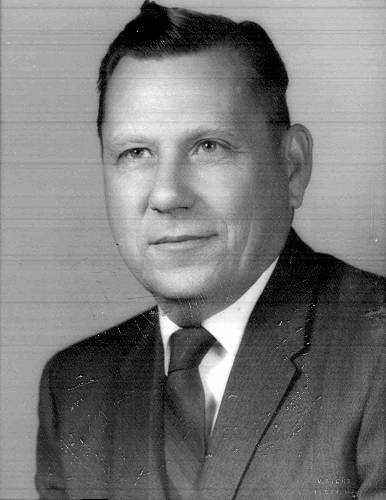
06 Carrol McCubbin
One of William Shelton Watkins sons was Bird Taylor Watkins (photo 07).
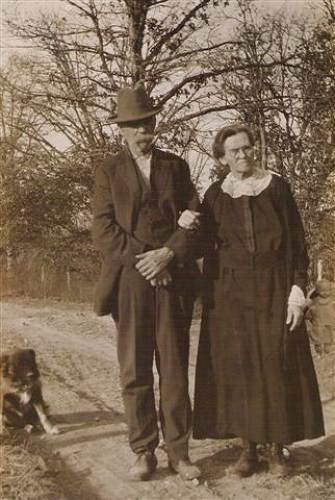
07 Bird Taylor Watkins and Mary Ann Hughes Watkins
He had a farm at Watkins. Peggy Hake wrote a short biography of Bird Watkins for the Autogram recently which I will copy here:
Miller County Autogram
August 25, 2011
Bird Taylor Watkins was born on the old Watkins farm in the farming area known as Watkins which had a general store and post office in the community. He was born May 7, 1858, and died at his home in Ulman on Aug. 3, 1934 at the age 76.
Bird was a son of William Shelton Watkins and his wife, Mary Jane, who came from Kentucky to Miller County and settled on the old Watkins farmland, northwest of Iberia.
On Dec. 14, 1879, Bird married Mary A. Hughes and they became parents of six children. Four of the children died in infancy. His surviving children were Mrs. Lewis P. Pemberton and Mrs. A. B. Clark. The four deceased children, all infants, were: Anna Watkins 1883-1885; Hilary 1883-1884; Hulda 1885-1885; and Herbert 1886-1886.
He was survived by his wife who lived until Dec. 17, 1938, and two daughters. His surviving grandchildren were named in his obituary and they included Phyllis Pemberton, Hilary Pemberton, Glennis Pemberton and Rosemary Clark.
Bird was also survived by a brother, P. M. Watkins and a sister, Mrs. William Irwin. Two brothers, Bowline and Emmett, preceded him in death.
His funeral services were held at the Baptist church in Ulman and his burial was at Hickory Point Cemetery. He was laid to rest in the same cemetery where his four infant children were buried in the 1880s.
One of Bird Taylor Watkins daughters, Stella Branche Watkins, married Lewis Preston Pemberton. Their son, Hilary Pemberton (b: 01 Feb 1905 d: 15 Jan 2002) wrote a humorous narrative several years ago which has been circulating recently. In Hilary’s narrative he presents his autobiography part of which was in the Watkins area when he was young. The story is of particular interest to those who have roots in Iberia or the Hickory Point area. Also, Hilary recounts the strange story of William Shelton Watkins for whom the town of Watkins was named. Included at the end of the narrative Hilary tells the story of a foot race at Tuscumbia to determine if the famous steps up the hill to the courthouse or a path along side the steps was the fastest way to the top of the hill. Because the narrative is long I will present it here as an attachment (photos 08 - 27):
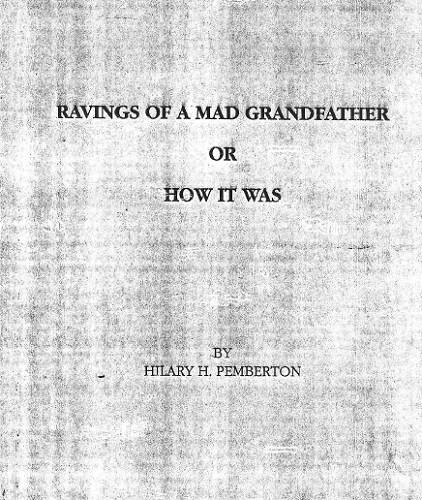
08-27 "How It Was" by Hilary H. Pemberton
Click image to read entire document in PDF format
Watkins is located about five miles northwest of Iberia. You won’t find it on a map anymore. However, on the county plat map it is located in section 8 Township 39N Range 13W. Coming north on Highway 17 out of Iberia about five miles turn left on Highway KK. You will know you are there when you see the Hickory Point Baptist church and the Hickory Point Cemetery nearby (photo 28).
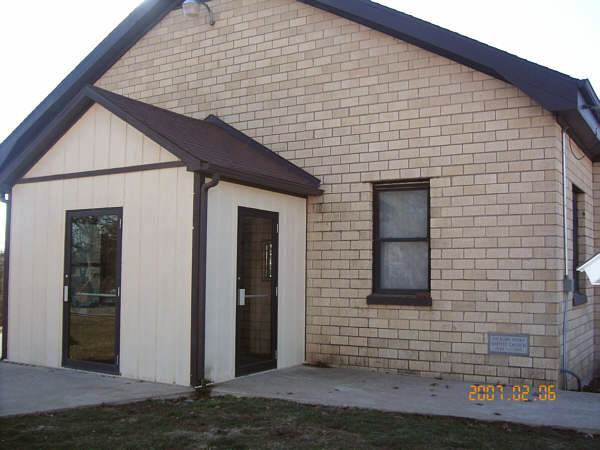
28 Hickory Point Baptist Church
Several of my grandfather Madison Bear’s relatives are buried in the cemetery, the most recent being Roy Bear, son of George William (Billy) Bear and Jenny Roberts Bear. Here is an old photo Roy’s family as well as his cousin Arthur Bear and Arthur’s daughter, Sandra (photo 29).
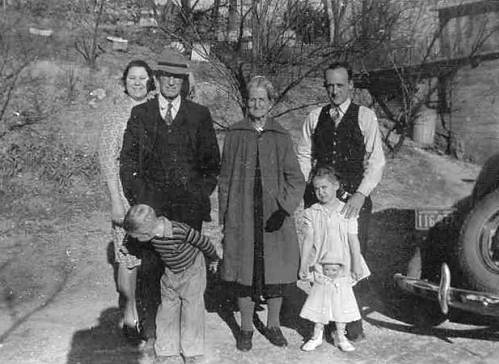
29 Jennie Bear, George Billy Bear, Cynthia Bear, Arthur Bear, Roy Bear and Sandra Bear
Identified in the photo are George W. Bear, his wife Jenny behind and on his right, George’s mother Cynthia to his left, Roy Bear in front of George, and George’s second cousin Arthur Bear with daughter Sandra to the far left of George.
George’s father, Andrew Bear, was a brother to my great grandfather, David Christian Bear and uncle to my grandfather Madison Bear (photos 30, 31 and 32).
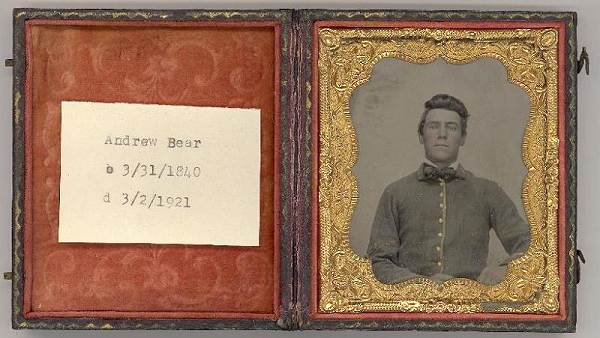
30 Andrew Bear
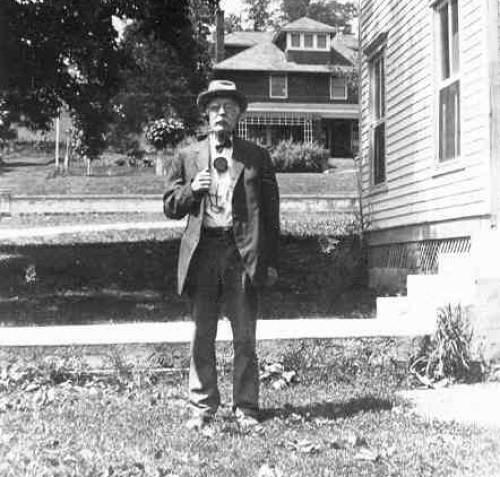
31 David Christian Bear
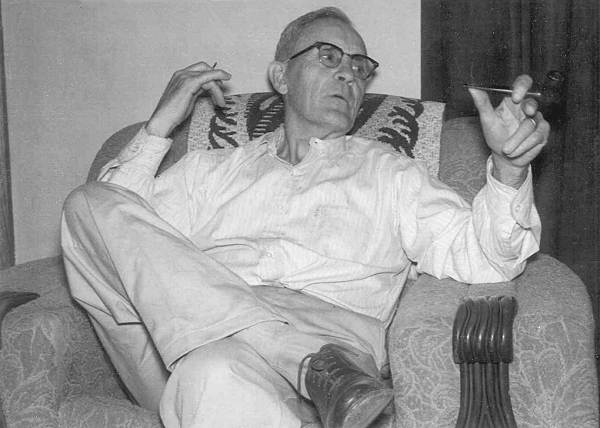
32 Madison Bear
You can read about the Bear family history on our website.
One of grandfather Madison’s uncles, Absalom Bear, who was a brother to his father David Christian Bear, made his home just about a mile south and west of the Hickory Point Baptist Church and Watkins (photo 33).
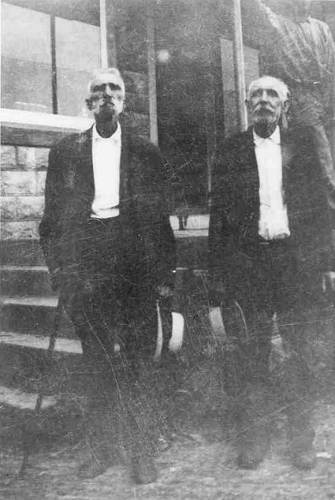
33 Absalom and David Christian Bear
The home was a large one originally made of logs with some framed rooms added on later. I took some photos of it and the barn a few years ago (photos 34 and 35).
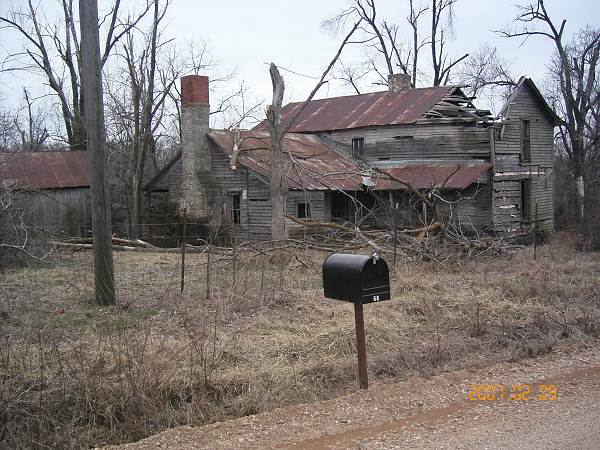
34 Absalom Bear Home
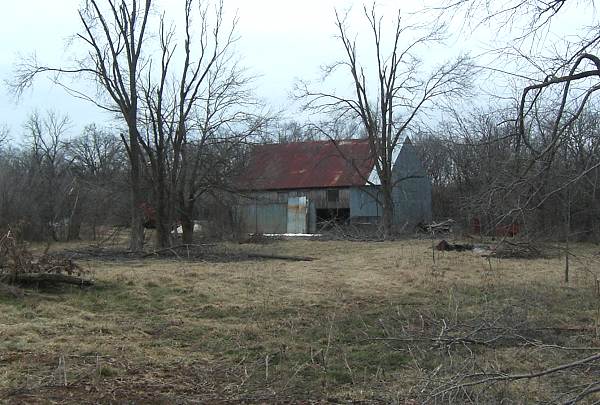
35 Absalom Bear Barn
The house has continued to deteriorate and I don’t know how much longer it will stand. Here is the 1905 plat map showing Absalom’s property south and east of Watkins (photo 36):
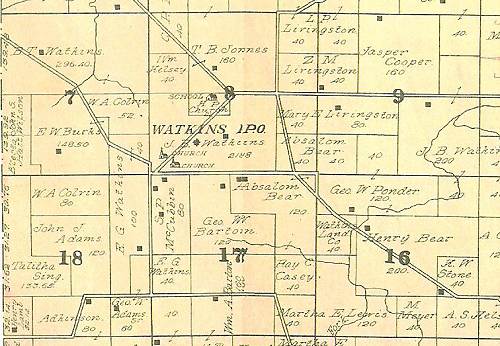
36 Closeup of Watkins - 1905
Click image for larger view
And here is the expanded township map T39N R13W which shows the area’s geographical location related to Iberia to the southeast (photo 37):
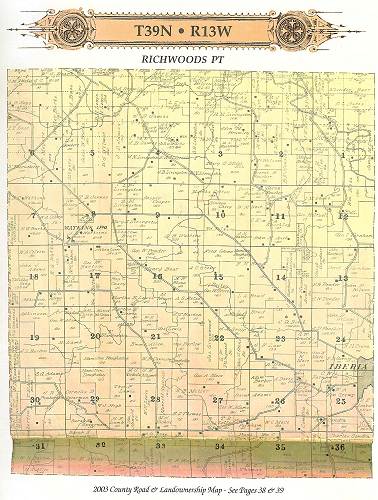
37 T39N - R13W
Click image for larger view
Absalom was active politically in the county having served as a district judge as well as judge on the county court. He also served a term as state representative. In addition, Absalom was a veteran of the Civil War. Here is an old tin type photo of him about the age he joined the county’s northern forces to fight the war (photo 38):
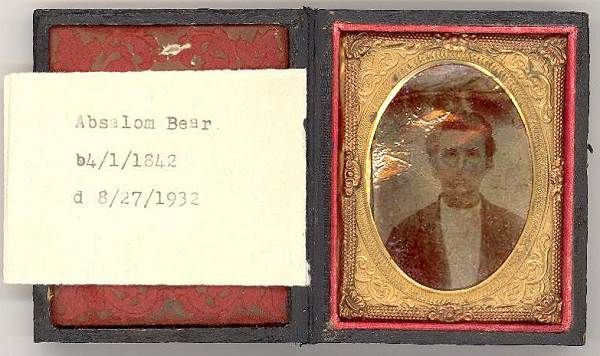
38 Absalom Bear in Civil War
Records show he joined Captain William Brumley's Company I, 47th Regiment Missouri Militia on August 11, 1862 and served until June 30, 1863; then with Company k, 9th Regiment Missouri State Cavalry from September 1864 to May 1865. His pension brought him $100.00 monthly (a fortune back then).
After the war Absalom was a member of the Iberia GAR (Grand Army of the Republic), an organization of veterans who fought for the north in the Civil War (photo 39).
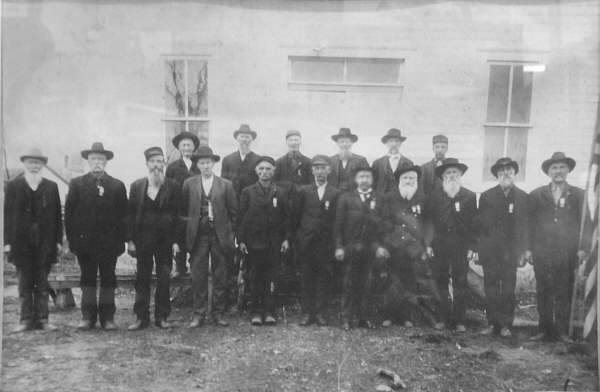
39 Iberia GAR
Here is the caption for the GAR photo:
Front Row L-R: Jim Berry, James Cross, Jerry Fallman, Epaminandos Deampird (E.D.) Hays, Steven Deardeuff, Simon Deardeuff, John Ferguson, Thomas Marchant, Absalom Bear, John Carroll
Back Row: Benjamin Fike, John E. Dickerson, George Teaverbaugh, Joe Crismon, William C. Thompson, John Brown.
The following obituary summarizes some of his life accomplishments:
Unknown Publication, August 1932
Absalom Bear, another one of the aged Civil War veterans and for many years one of Miller County’s most influential citizens, passed away at him home near Watkins last Saturday morning following a prolonged illness. Mr. Bear was a civic, religious and political leader among his fellow men and his passing will leave a vacancy hard to fill.
Absalom Bear, born April 1, 1842, in Hocking County, Ohio, died August 27, 1932, age 90 years 4 months and 27 days. He came with his parents from Ohio to Miller County, Missouri in 1857, and located near Tuscumbia. He was the son of George and Elizabeth Bear, the sixth in a family of nine brothers and two sisters, all of whom have preceded him in death, except his youngest brother, David, of Tuscumbia, Missouri.
When the Civil War was declared he enlisted in the Missouri State Militia Volunteers and served three and one-half years in the Union Army. At the close of the War he returned to Miller County and on December 5, 1872, was married to Mary Catherine Spearman and located on a farm near Hickory Point where he resided until his death.
To this union were born ten children, two of whom died. Sarah Catherine at the age of 8 years and seven months and Veronica Amy at the age of twelve years and nine months. His wife Mary Catherine preceded him in death April 1, 1905, at the age of 53 years, 3 months and 4 days. Eight children survive: Nancy and Edna at home, George of Kansas City, Missouri, Mrs. Martha Atteberry of Atoka, Oklahoma and Zebedee also of Oklahoma. Mrs. Zella Livingston of Iowa City, Iowa, John K. of Iberia, Missouri and Frank C., Shreveport, Louisiana. There are also eleven grandchildren all of whom survive.
He united with the Christian Church in 1873. He helped organize the Christian Church at Hickory Point in 1878 and was an elder in the church until his death.
He was also active in all community enterprises and served two terms as Judge of the Second District, one term as presiding Judge of the County Court of Miller County and one term as Representative in the State Legislature.
Funeral services were held at the Hickory Point Christian Church Sunday afternoon. Rev. W.H. Scott of Eldon officiated, giving a very helpful and impressive sermon. An appropriate song service was rendered, led by Mr. Tennyson Wright and choir. The body was laid to rest in Hickory Point Cemetery, burial services conducted by Clarence L. Casey, assisted by the American Legion of Iberia. Numerous relatives and friends attended and several floral offerings spoke plainly of the high esteem in which the deceased was held.
Here is a photo of Uncle Absalom and his family taken probably sometime in the 1880’s. The comments were made by my Uncle David Bear, grand nephew of Absalom (photo 40):

40 Absalom Bear and Family
And here is a later photo of Absalom and some of his family also containing comments written by David Bear (photo 41):
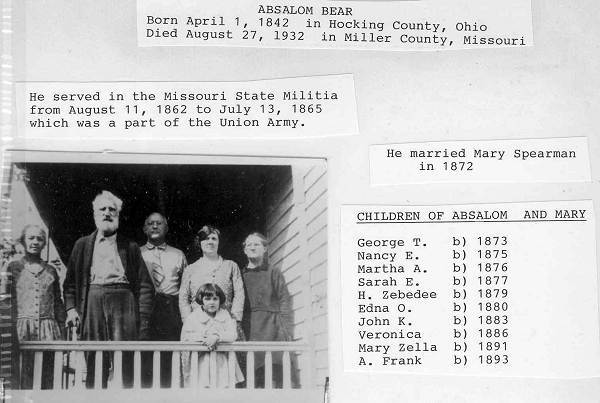
41 Absalom Bear and Family on Porch
I talked with Ruby McCubbin Spearman at her home near Watkins a few years ago about my great great Uncle Absalom Bear (sadly, about a year ago Ruby passed away).
Ruby owned the old Absalom Frank Bear (Absalom's son) farm which was close to the original Absalom Bear farm nearby. Ruby knew Edna Bear, one of Absalom's two spinster daughters, who continued to live in the family home after Absalom died (Nancy, Edna’ sister, died in 1933). The old house was made of huge logs which later were overlayed with boards. Ruby's father, Clyde McCubbin, used to plow the farm for Edna and Nancy with a one row plow share and team of horses. The field he plowed was to the south of the barn and was sixty acres. Probably, it would have taken a long time to plow that much ground. According to Ruby the following is a rough guide:
Assuming a well conditioned team, equipment in good repair, and 10 hours in the field, with two 1,500 pound horses, in one day you can expect to:
- plow 1 1/2 - 2 acres
- cultivate (single row) 7 acres
- harrow 8 - 10 acres
- mow 7 acres
- drill 8 - 10 acres
- rake 14 acres
- plant 8 - 10 acres
- haul on a wagon 1 1/2 tons 20 - 25 miles
Absalom Frank Bear, son of Absalom, was also a WWI hero.
Locally, in Watkins, Absalom was very active in the organization of the Christian Church. Here is a photo of it not long before it was blown away by a tornado some twenty or thirty years ago (photo 42):
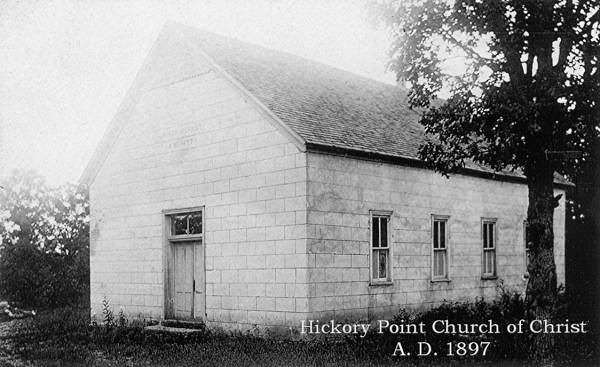
42 Hickory Point Christian Church
A few years ago I wrote an article about the Watkins Christian Church with much of the information being supplied me by Ruby McCubbin Spearman:
Hickory Point Christian Church
Joe Pryor
According to Goodspeed’s History of Miller County:
“Hickory Point Church began its career in August, 1878, under the direction of Revs. N. Davis, E.W. Burks and Absalom Bear. Their membership of twenty three has since increased to eighty eight under the successive pastorates of Revs. N. Davis, J.H.D. Thomson, J.C. Martin, D.T.Connor, J.H.Aust and E. Wright. They still use their log building, erected in 1879, eleven miles south of Tuscumbia.”
Note: The photo 42 above was taken after the log building was replaced.
A short paragraph in a history of Miller County Baptist churches published by the Miller County Baptist Association states that in the late 1800’s the “Alexander Campbellite Movement” came into the area and as a consequence a good number of people left the Hickory Point Baptist church and started the Hickory Point Christian Church.
In the booklet, “Hickory Point Baptist Church: 150th Anniversary”, compiled by Iris Burks, the following is quoted: “In this year (1854) the first mention is made of the Alexander Campbell Reformers coming in. This split the church wide open, and according to the records, about one third of the members’ names are marked ‘excluded’ and those remaining are marked ‘transferred,’ which could mean they started all over.”
According to Ruby (McCubbin) Spearman, who was born in 1930 and attended Hickory Point Christian church all her childhood life, the McCubbin family was one of the most important supporters of the church at that time. Upon review of the Hickory Point Baptist Church 150th anniversary booklet, a number of McCubbins who were some of the original members of the Hickory Point Baptist Church are no longer listed after about 1860. Also, the McComb name, which Mrs. Spearman reports was the name of one of the families which attended Hickory Point Christian Church, was no longer listed among those attending Hickory Point Baptist Church. Therefore, it is likely that many of the early members of the Hickory Point Baptist Church were instrumental in starting the Hickory Point Christian Church, which was located just a quarter mile north.
Mrs. Spearman’s father, Clyde McCubbin, was one of the elders at Hickory Point Christian Church. She remembered the church being constructed of lime stone with a sign above the door saying it was built in 1897. I suspect this was not the first church since Goodspeed above records that the church actually was started in 1879 and was made of logs. Mrs. Spearman remembers that members of the Bear family were said to have been early supporters of the church having donated money and land. Absalom Bear was a name she heard mentioned often although she never remembers seeing him since he died in 1932 ( the farm, including the house built in 1918 in which she now lives, originally belonged to Absalom Frank Bear, a son of Absalom). The preachers she remembers as a little girl were Frank Moneymaker, and a “Preacher Wood” who came there in 1929 from Indiana. Mr. Wood also preached at Pension Ridge church and “stayed with a Mr. Rodden.” She remembers that Preacher Wood was of Church of Christ background which did not believe instruments were appropriate for the worship service. He and Nancy Bear, daughter of Absalom, were fond of each other and were to be married; however Nancy died suddenly of pneumonia. Mrs. Pearson was told by her father that Nancy only would let women take care of her and that she would not see a male doctor.
Another preacher who was of the non instrumental persuasion was John Davenport, grandfather of Camilla (Patterson) Dake, whose husband Everett Dake’s family was regular in attending the church. Mr. Davenport was the grandfather of Mrs. Dake on her mother’s side. She reports that Mr. Davenport rode a horse and buggy to Sunday services from his home in Ulman, Missouri, three miles to the north. He often would travel further south to preach in the yard of Mrs. Dake’s Patterson relatives and family.
Another famous Miller County Church of Christ minister who preached at Hickory Point Christian Church was J.H.D. Thomson (photo 43).
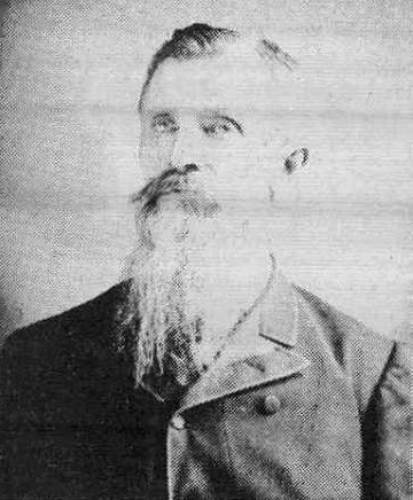
43 Reverend Josiah Henry Dockery Thompson
Apparently, the Hickory Point Christian church at times was non-instrumental and other times used a pedal organ. The pedal organ, according to Mrs. Spearman, originally had been given to the church by the Bear family in the late 1800’s when the church was started, but in later times was not used.
Some of the family names remembered by Mrs. Pearson of people who attended the church were Bear, Dake, Williams, McCubbins, Slone, McComb and Case.
In 1965 severe wind damaged the church and blew off part of the roof and wall. Thieves began breaking in and stealing articles. The members of the church removed benches and other more valuable articles and dispersed them among other members to prevent them from being stolen. Because the church attendance had been falling a decision was made not to rebuild the church. Mrs. Spearman had the opportunity much later to purchase at a sale the old organ which originally was donated by the Bear family. She remembers that her father, Clyde McCubbin, who was an excellent musician, repaired the organ. He was perplexed, she relates, that the wooden percussion hammers and rods and other elements of the inside workings of the organ were covered by “sugar and salt”.
Note: Ruby and I speculated that maybe the organ had been sabotaged by one of the non instrumental preachers, or someone sympathetic to that belief.
Mrs. Dake recalls that she and her husband were fortunate to have the opportunity to purchase an old candle chandelier which once belonged to the church and which now hangs from the ceiling in their living room. She recalls that some of those who attended Hickory Point Christian Church later attended Mt. View Church of Christ which was located at the highway 17 KK junction.
Thanks are given to Mrs. Ruby Spearman, Mr. and Mrs. Everett Dake, Sue Wall, and Catherine Ponder. Other sources included Goodspeed’s History of Miller County, Miller County Baptist Association, and Hickory Point Baptist Church: 150th Anniversary.
At some point in time, Nancy and Edna, the two spinster daughters of Absalom, donated their piano to the Iberia Christian Church.
As I was growing up in Tuscumbia my grandfather Madison Bear told me many stories about Absalom. One of the stories was that in younger days he, like many others in that time frame long ago, liked to fist fight as a sport. On one occasion my Uncles Arthur and David Bear reminisced about the sport of fist fighting years ago when Uncle Absalom was a young man. The conversation was recorded and a transcript is copied below (photo 44):
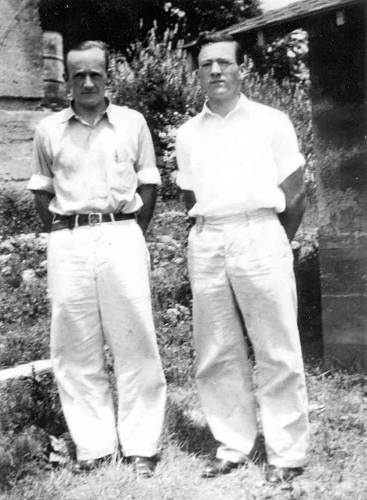
44 Arthur and David Bear
Arthur: Grandpa (David Christian Bear) told me about a man in Tuscumbia named John Fogelman (photos 45 and 46).
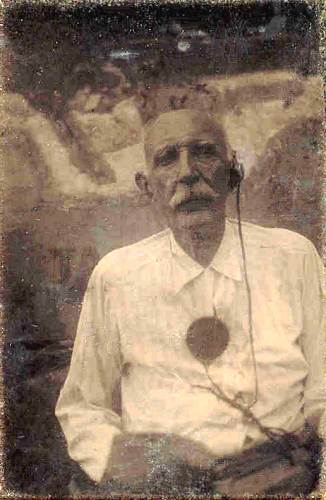
45 David C. Bear
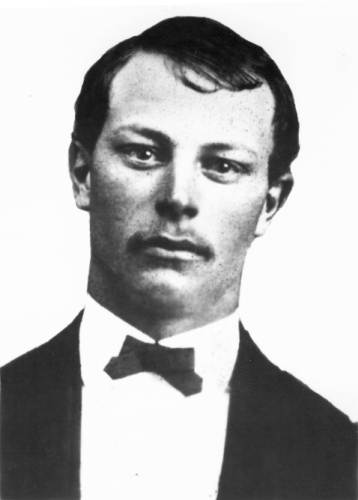
46 John Wilson Fogleman
He was a huge German who challenged Uncle Absalom one day and wanted to wrestle him. Uncle Ab said, "No I won't wrestle you, but I'll fight you. I know your game. You want to see if you can get me down and then you would whip me. So, there'll be no wrestling, but I'll fight you. We'll do our fighting standing up." Fogelman knew that Uncle Ab was too much for him in bare knuckle fighting, so I don't think the fight ever took place.
David: Evidently, Absalom was quite a fighter. His height was well over six feet, and he was unusually big through the arms, shoulders, and neck. His arms were long enough that he had a long reach. From all the stories I heard, he was never bested. There was nobody around who could whip him in a bare knuckle fight.
Note: Here is a photo of Absalom at an older age but notice how large his hands and feet are as well as the length of the arms (photo 47):
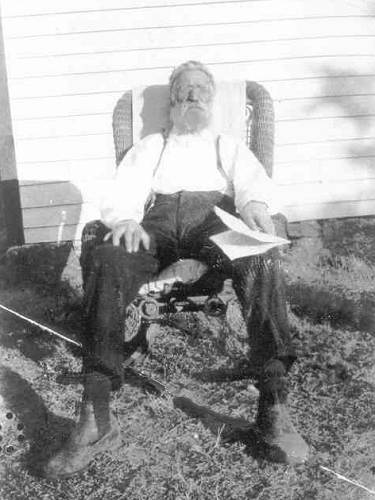
47 Absalom Bear
Of course, all the stories came through the Bears. They were a tough bunch. Not all of them were as big or as strong as Absalom. George was also very adept. They all tended to hold together if any gang fighting developed.
David: What has been described was typical of what went on. Sometimes another community would be the scene of action where the fighting would occur such as Capps, Charley Town, (now known as St. Elizabeth), Iberia, Ulman or Brumley. I don't know that the Bears went to all these places, but they did move around. All the small towns were very similar. Now, think about it, if you didn't have entertainment like we have today, you would create some of your own. Physical prowess was something that people were proud of, especially if they were good at it. But to not accept a challenge could brand a person as a coward. These activities, as described created a lot of community interest. Arthur, what else do you want to say on this topic?
Arthur: As you say, these activities were helped along by liquor. The young people learned early in life to drink it. Grandpa told me once that back in that period, it was not safe for a woman to walk down the streets of Tuscumbia alone because of the drunks.
David: I have heard that Grandpa didn't drink liquor like the others. I don't know if it was against his principles or whether he was one of those people who couldn't handle it. At least he learned quite early in life not to use much of it. In addition to imbibing for pleasure, they all thought that liquor was very good medicine, so there was a lot of sickness (a few har hars here). Those were the days before prohibition and heavy liquor taxes, so I guess many people made their own or got it from someone who did. There was never a shortage.
Arthur: I don't know where they got it, either, but at that time it was legal. One day Uncle George and Uncle Ab were down at St. Elizabeth attending a picnic (photos 48 and 49).
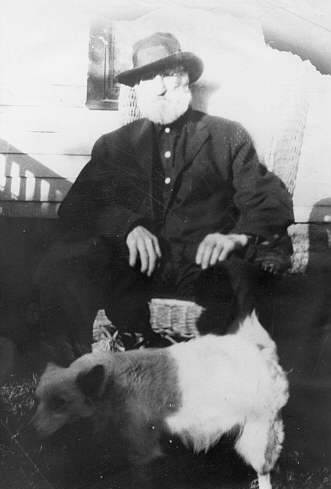
48 Absalom Bear at Home
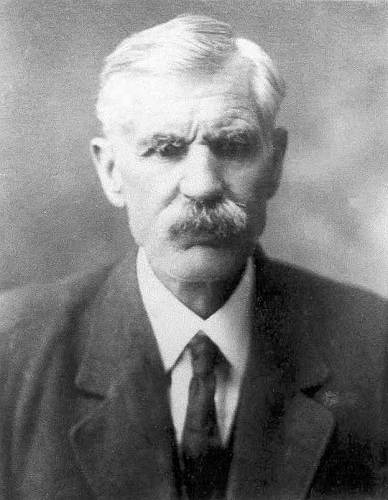
49 George Bear Jr.
Maybe Grandpa was present, but I am not sure. Liquor was always a part of the celebrations and this always brought out the rowdy behavior in people. It also gave courage to those who wanted to whip somebody to improve his reputation as a fighter. Since the Bear boys had a reputation as fighters, the sheriff, Kellis Martin, and several others decided to pick a fight with them. The fight got started, and one of them used a knife on George and put him out of the fight. Uncle Ab knocked the sheriff to the floor and then put his foot on his neck to hold him down while he dealt with the others. Finally Uncle Ab looked down at the sheriff and saw that he was turning blue in the face from lack of air. This caused concern from all present and the fight wound down.
David: Yeah! Well, they had a lot of stories like that, and our cousin, Frank Martin, knew all of them, but he is not with us anymore to refresh our memories (photo 50).
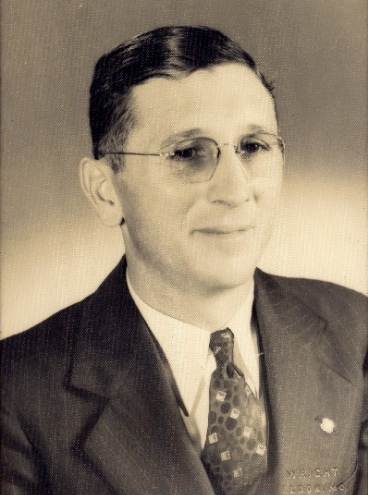
50 Frank Martin
Many of the stories centered around uncle Ab. Many people wanted to whip him, but those who tried were unsuccessful.
Uncle Absalom lived long enough to reach the time of the introduction of home cameras offering us today a couple more of him which are posted below (photos 51 and 52).
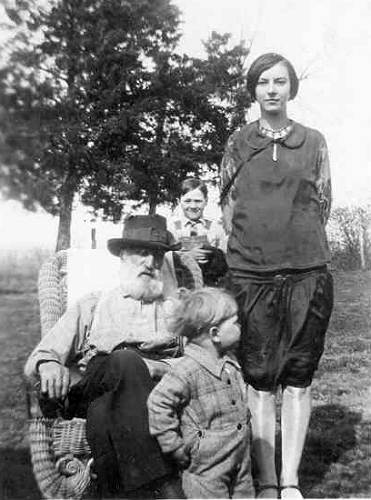
51 Absalom with grandniece Milded Adcock Smith and two Grandchildren
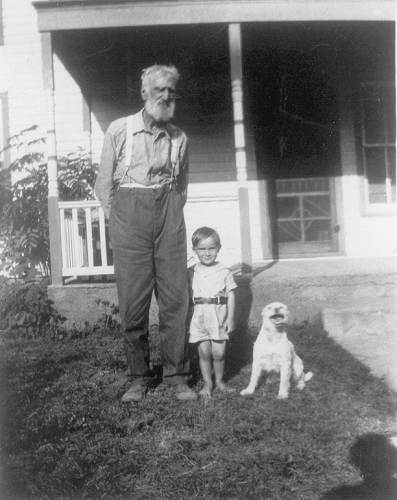
52 Absalom Bear with Great-Grandson
Before leaving the story of Watkins I want to refer you to the history of the Hickory Point Baptist Church which today remains a vibrant well attended congregation with a very interesting story. You can read about it on our website.
Scroll half way down the page to reach the narrative and photo of the church.
Alice Hawken called me recently to tell me she had a couple of items for me to consider whether we might want to display at the museum. I have always enjoyed my relationship with Alice as she is one of the older residents of the town having lived here most of her life and is a good source of Tuscumbia history. She was a daughter of Pearly Keeth who lived in Tuscumbia for many years after moving here from Crocker with his family. Alice married Tuscumbia native Andrew Hawken who passed away several years ago. I had written about Alice’s family at this previous Progress Notes.
The first item Alice had to show me was a really old plate with a full calendar of the year 1912 given many years ago to customers of the Bank of Tuscumbia. Here is a photo of Alice holding the plate and another of a close-up of the plate (photos 53 and 54):
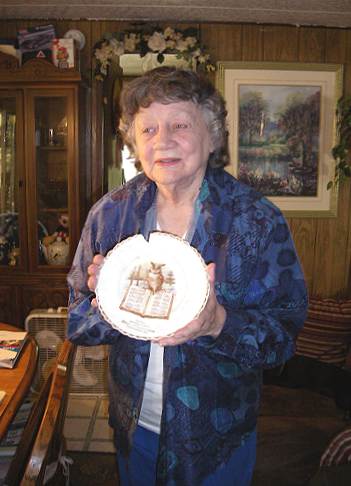
53 Alice Hawken
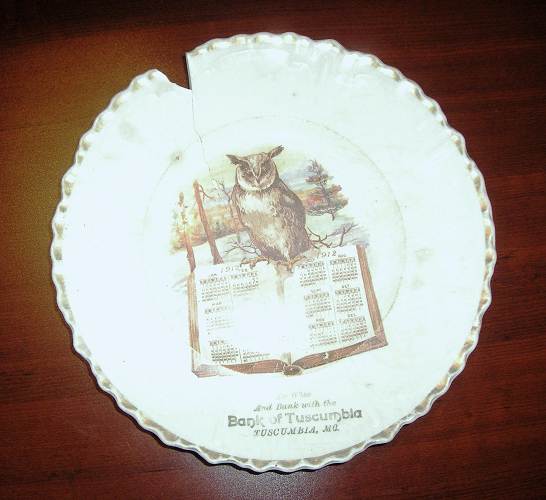
54 Bank of Tuscumbia Calendar Plate
Many will remember that at the beginning of each year the bank often gave free calendars with scenic photos but I had never seen an example of a plate with a calendar having been given by the bank. Alice said the plate was given her by Sadie Clark of Tuscumbia many years ago.
Another item Alice wanted to show me was a painting of a rural farm scene that accidentally was found between two walls of the old Woodman Fellowship Hall building in Tuscumbia. Here is a photo of the building taken in the mid 1940’s when owned by Jim Sweaney (photo 55):
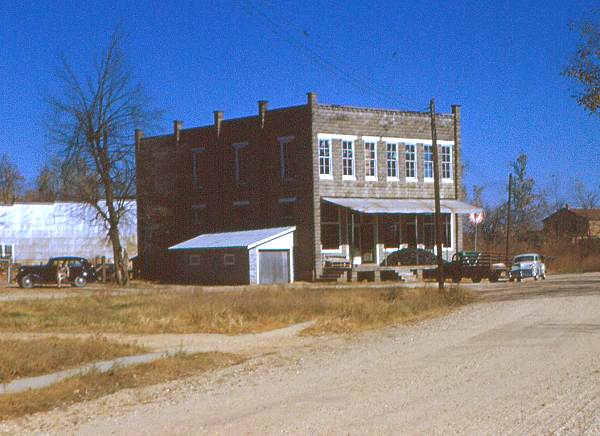
55 Woodman Fellowship Hall Building
About thirty or more years ago Alice said Hilda Hager, who owned the building at the time operating a tavern and restaurant, was remodeling and in the process knocked out a wall finding a dead space with the painting nailed to the inside of the adjacent wall. Apparently, the second wall was built for stabilization and the painting was left in place (photo 56).
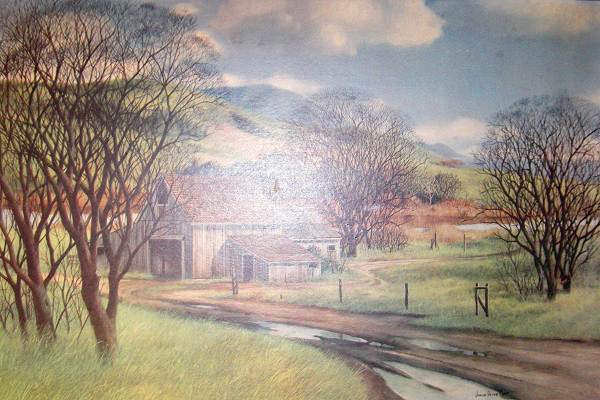
56 Spring Is Near
I saw that the artist’s name was James Peter Cost. However, the painting was a reproduction and not an original and wasn’t an antique as Mr. Cost was born in 1923 and died in 2002.
So we really hadn’t discovered a long lost treasure but it was fun for awhile to speculate as to why someone would have left the painting (really a print) on that wall since it was in good condition and well done.
My mother’s family had rented the Woodman’s Fellowship Hall building in the late 1920’s and 1930’s from Mrs. Ida Hauenstein to operate a grocery store. Here is a photo of mom (Susie) and some of the family on the porch of that old building now no longer standing (photo 58):
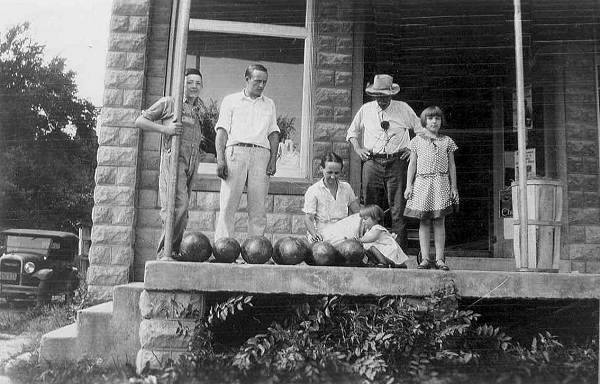
58 Bear Store: David, Arthur, Sadie, Bonnie, David C. and Susie Bear
Mom couldn’t remember her family constructing a second dividing wall creating the dead space where later the above mentioned picture was found so it would have to have been placed a number of years later. However, she did have some interesting memories of how that area was used by her parents when they operated their grocery store there:
Joe, I well remember that wall that divided the store. All the merchandise ready for sale was placed out front and the space behind the wall was for storage. It was very crowded. That is where Rex Wyrick (father of board member Karen Smith) and I were playing and Rex fell in a large can of lard & Gertie, his mother, wasn't home so his father Clyde took him next door to the Farmer’s Exchange store which they managed (photos 59, 60 and 61).
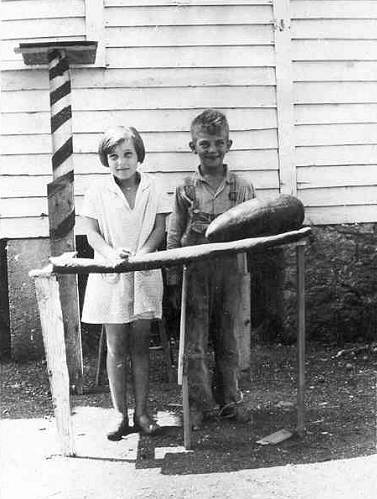
59 Susie Bear and Rex Wyrick
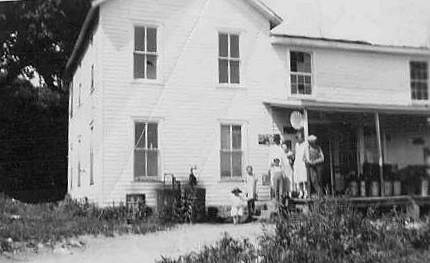
60 Farmer's Exchange Store: Gertha Wyrick second from Right
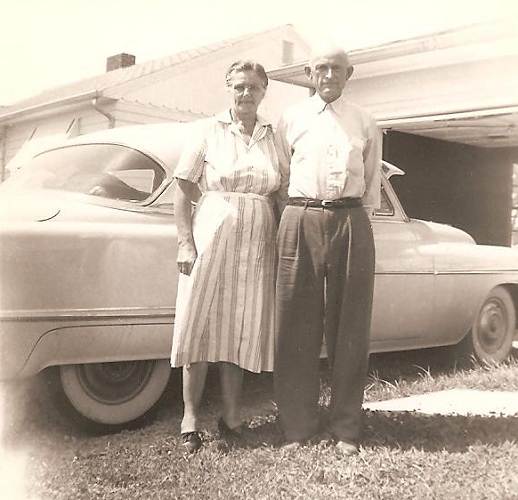
61 Clyde and Gertie Wyrick - 1952
In the back of the Exchange was a small spring of water & he tried to wash the lard off Rex’s blue jeans but since the water was cold he didn't have any luck getting the lard off.
And another time back in that storage area Nathalie Hicks fell in a large can of molasses which was stored there & she had to go home. I don't remember the outcome of that but I’m sure it “was a sticky situation!”
But the folks never did forbid us from playing in there. Mom had to take us five kids with her down to the store every morning from our home over in Goosebottom because she had to work & we had no other place to go to be watched than down there. It really was a large long room & a good place to play hide & seek! They kept some large things they sold in there too, such as a few washing machines. The brands were Dexter as I remember & they ran by gas motors, not electricity. Also stored there were a few small pieces of farm machinery, such as small plows, and other smaller tools for farmers. I remember they had a table where they kept some salt cured bacon, also salted pieces of pork. We called it the back room & town people would buy it since they didn't cure their meat in their homes in town like the farmers did who raised the hogs and had places to cure or smoke the meat.
But to answer your question, I never saw a painting or picture on the wall like you said Hilda found there that day. It must have been put there at a later time.
Recently, I was contacted by Professor John Schultz, son of the well known Miller County Historian and Iberia Academy professor, Gerard Schultz now deceased (photo 62).
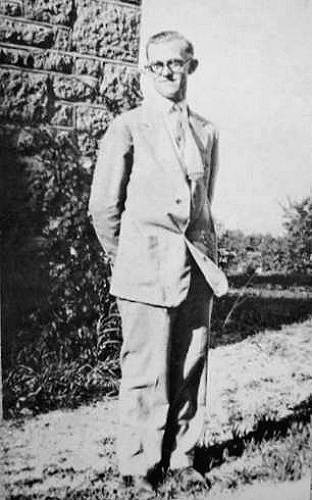
62 Gerard Schultz
John is arranging a “Wilson-Brumley” get together for all who are interested for October 28, 29 and 30.
Copied below is the letter John sent me and others who have a familial relationship with the Miller County Wilson-Brumley families as well as those who have a general interest in knowing more about the history of these two interesting Miller County families and their descendents. John told me that all interested are welcome to attend this historical occasion. I will present more details as provided me by John later:
FINAL WILSON-BRUMLEY DATES.
The dates for our Wilson-Brumley get-together are set for October 28, 29, and partial day and probable fly-home day Oct 30, Sunday. Families with young kids will want to be back for Halloween and school. That gives us about three weeks from now until Friday Oct 28.
I will try to make arrangements for audio and video covering of the event.
I've talked to Ralph Hendley on whose farm the Brumley cemetery rests. And I've talked to Mrs. Roark on whose farm the Wilson Cave is located, where John "Uncle Jack" Wilson (first Caucasian permanent settler in this area along with William Miller) lived for the first half of the 19th century. He lived at first alone with Indians from the large village that was located where Brushy Fork and Barren Fork come together and flow into the Big Tavern, and then with his wife Nellie Rae and children, and more stories about all this later.
Both Ralph Hendley and Mrs Roark have generously offered us access for the event.
We should gather at the America's Best Value Inn and Suites (formerly Heritage Inn) in Eldon (573-392-2100), close to Hgwy 54 and 52 junction, by late afternoon or early evening of Oct 28.
About 1807-1809 John "Uncle Jack" Wilson was the first permanent Caucasian settler along with William Miller in what is now Miller County, in the whole area, in fact, south of the Osage River. John Wilson, 55 years old, walked to the area, first from Kentucky to a bunch of cabins called St. Louis at the confluence of the Missouri and Mississippi Rivers, and then alone to the large Indian village that was located where we will meet. The last hike was possibly close to a 200 mile trek taken all in all, most of it through "wild" areas visited only by fur traders, if we are talking Caucasian visitors. He carried two books with him. He arrived in early November, too late to go back. Without the generosity of the Indians, and probably because he spoke fluent Shawnee, the trade language of the whole broad area now covered by several states, he would not have survived that first winter. The two books were important to him. We will ask the audience to guess at the titles of the two books. The early settlers were better educated than media myths usually allow. They read well, kept wonderful diaries, and knew working math. The story of the Wilsons and the Brumleys (who came only a little later and may have known Uncle Jack in Kentucky) will take us to sites nearby, too.
Sisley Wilson, granddaughter of Uncle Jack and Nellie Rae, married William Carroll Brumley, both in their teens, in mid-Nineteenth century, social stars of their area and time. Uncle Jack lived to be 101, outliving many of his family. He probably stood witness at the wedding of his granddaughter, we will see. He kept going back to the cave to live, even when he and Nellie had a cabin and a 440 acre stretch of land. She did not share his love for the cave.
They lived in a cabin near the Indian village, which was also located on the Roark farm on the high ground inside the fork of the meeting of Brushy Fork, Barren Fork, and the Big Tavern. The Indians living in the cave and then in the village were quite numerous at the time, about 500, bigger than Iberia when the brothers Schultz lived there. The Indians had been there for hundreds of years.
William Carroll Brumley, grandfather of John Brumley, was a militant and vigorous lieutenant in the Union militia in a very divided area, politically and viciously divided. He later was sheriff and a tax collector for Miller County. His vigor as a union lieutenant in the Civil War and as a Radical Republican afterward may have earned him the enmity of the confederate James brothers, though obviously he was elected by a good majority of Miller County voters. He had an encounter with Frank James, who was not at all the temperate nice guy he is sometimes portrayed as being. William Carroll became a landowner--we would call it a ranch--of more than 3,000 acres, owning most of the valley we will be visiting. The Hendley house incorporates the large stone fireplace and chimney of the old "Big House" of William Carroll and Sisley. The "Big House" burned down in 1912. Jennie Lee Brumley Schultz, mother of John, Gerard, and Dan, remembered being in the Big House as a small girl.
The above, of course, is only a beginning. I've done fairly extensive research and talked, on several trips, with everyone I could find, including Clyde Jenkins, former judge and historian of the area, author of a very helpful History of Miller County, and I remember the stories from the books and tellings of Gerard William Frederick Schultz, father of John, Gerard and Dan, who did the earliest research on these stories for his books The History of Miller Country and The Early History of the Northern Ozarks. Clyde let me have copies of many documents and stories that he got hold of after his book was published. The Miller County Historical Society has shown a strong interest in helping with our project, as have cemetery and family historian Peggy Hake, and also Joe Pryor, who has done work on the history of this area. Joe Pryor wants to take part, and we welcome him and Miller County museum's board of directors. Joe, a medical doctor and historian, is president of the Society. Joe wishes to post this notice on the Society's website. Our cousin Scott Bridgewater, son of Jennie Lee Scott Bridgewater (daughter of Evelyn Brumley Scott), wants to join us, coming from Washington D.C. He's an engineer with NPR. We hope he will bring his six-year-old with him, joining other kids coming from West and East Coasts.
We will be able to spend all of Saturday Oct 29 on the project and maybe part of (or all of) Sunday 30th, as people are able. Some will wish to go see family sites on Sunday. I will tell stories at both the Wilson and Brumley sites, and I want to have others tell stories that have come their way. I want to arrange the equipment to record our visit and what we say and find out. There are Brumleys in Houston, TX and in Mississippi. Ralph Hendley has taken excellent care of the cemetery and is interested in our project. His grandson, Jake, also.
About a week ago, October 9, 2011, I joined others of my 1961 Tuscumbia High School Senior class to celebrate our post graduate fiftieth year anniversary. The Tuscumbia High School Alumni Association sponsors an annual alumnus meeting at which the fiftieth year graduates are honored to be seated at a special table with first in line privileges for the excellent meal always prepared by the culinary staff of the Tuscumbia School system.
Through the years our class number varied between 13 and 15 students. Of the fifteen students who were graduated, nine attended the reunion October 9.
Attendees arrived at different times so a complete group photo was not made; however, here are two photos taken which together includes all who attended (photos 63 and 64).
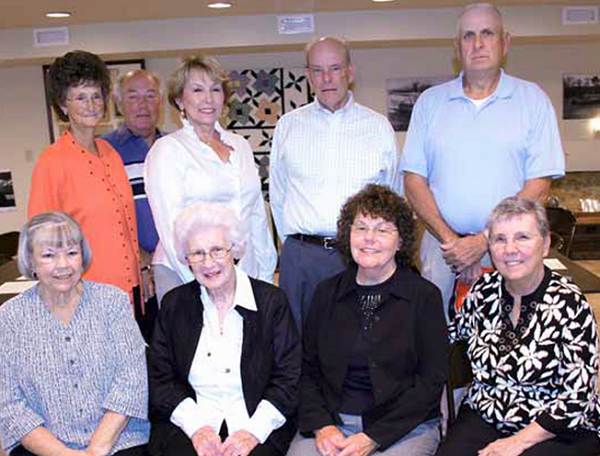
63 Members of the Tuscumbia High School class of 1961 gathered Saturday afternoon, Oct. 8, at the
Miller County Museum in order to visit before the annual alumni banquet that evening.
Class members are, from left, front, Sharon Helton Abbott, the class’ sixth grade class teacher
Helen Schulte, Rose Kratzer Flora and Kathy Martin Fields;
back, Linda Thompson, Don Robinette,
Nancy Slone Kays, Joe Pryor and Kenneth Rush.
(Photo by Ginny Duffield)
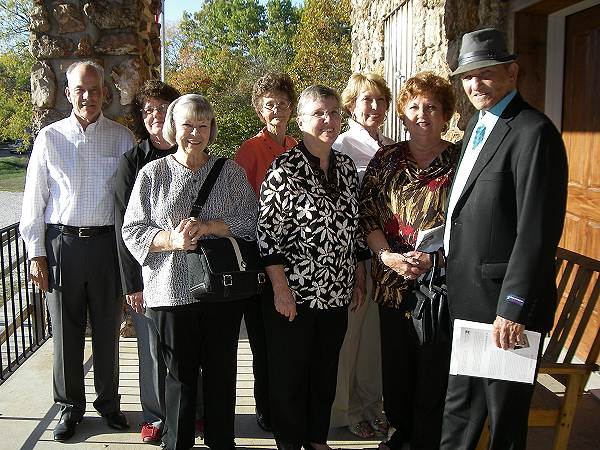
64 Joe Pryor, Rose Kratzer Flora, Sharon Helton Abbott, Linda Thompson Birdson,
Kathy Martin Fields, Nancy Slone Kayes, Caroline Patterson Pryor and Harold Patterson
One honorary attendee was Ms. Helen Heafy Schulte, our 6th grade teacher who also has been a long time board member of the Miller County Historical Society (photo 65). Our class was the first Helen taught in which no other classes were combined in the same room.
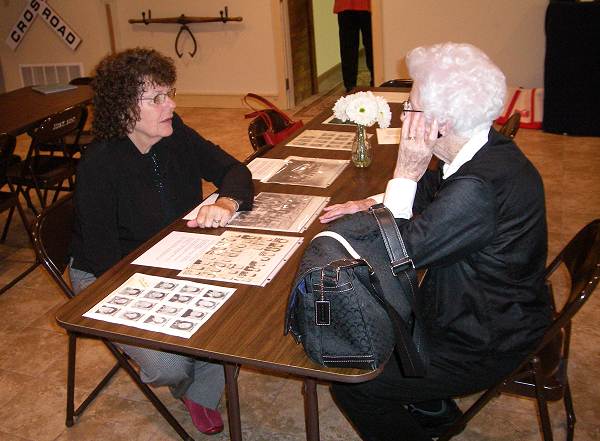
65 Rose Kratzer Flora and Helen Schulte
Ginny Duffield of the Vernon Publishing Company was present taking photos also (photos 65a - 65d):
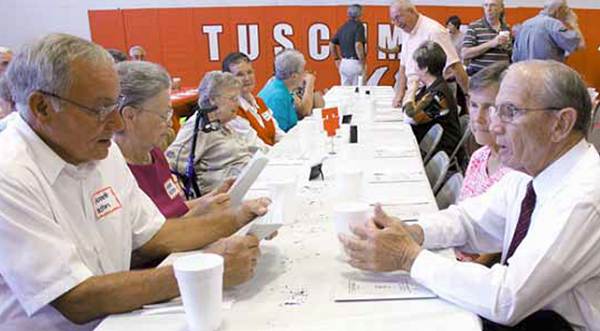
65a Visiting prior to the start of the Tuscumbia High School Alumni Banquet Saturday evening
are Bennett and Arlene Helton, left, and Jack and Joyce Brumley.
(Photo by Ginny Duffield)
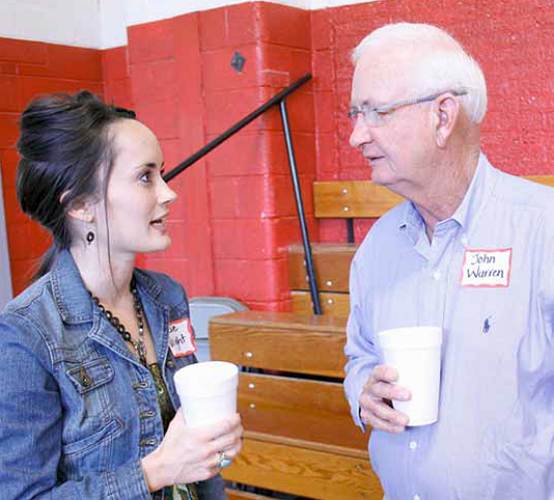
65b College student Kacie Wright visits with her uncle John Warren Saturday evening at the
Tuscumbia High School Alumni Banquet. Wright was one of the more recent graduates attending
and Warren is from California and was among those traveling the farthest to
attend.
(Photo by Ginny Duffield)
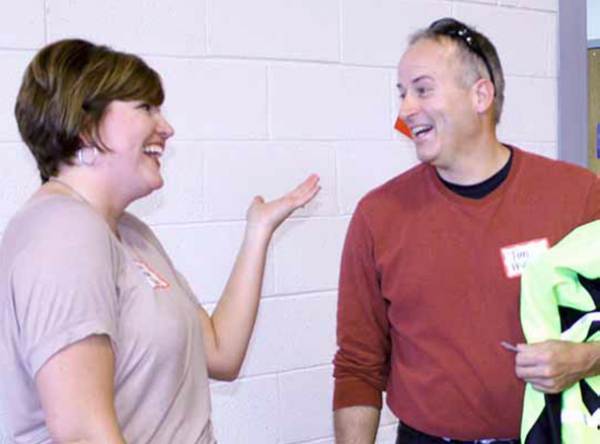
65c Sharing a laugh with her uncle Tim Pryor at the Tuscumbia Alumni Banquet Saturday is Tina Pryor Matzen.
(Photo by Ginny Duffield)
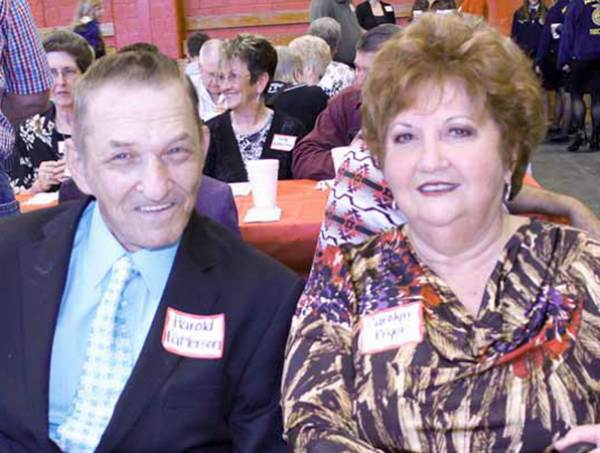
65d Also members of the THS Class of ‘61 are Harold Patterson and his sister,
Carolyn Patterson Pryor, who attended the alumni banquet on Saturday.
(Photo by Ginny Duffield)
Entertainment at the event was provided by the fifties style rock band, “Terry Lee & The Rockaboogie Band” from the state of Indiana. Dancing was enjoyed by some in front of the stage (photo 66).
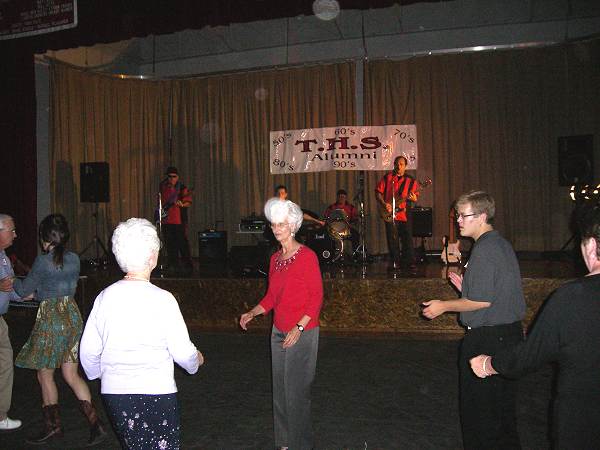
66 Rockaboogie Band
The Tuscumbia school matriculates an average of about fifteen students yearly so the gym is large enough to invite all previous graduates to attend the yearly event.
Most of the 1961 class met at our Miller County Museum a few hours before the formal event that evening for conversation and catching up on our classmates lives since graduation. Photos of our class from grade 1 and grade 12 were found for all to view (photos 67 - 70).
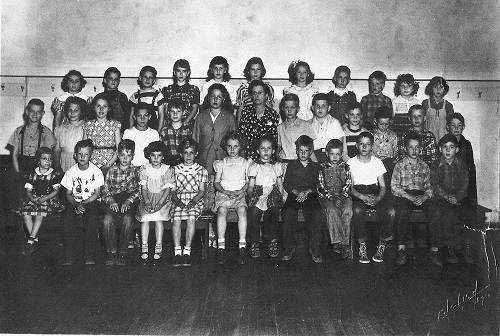
67 1961 Graduates 1st-4th Grades
Click image for larger view
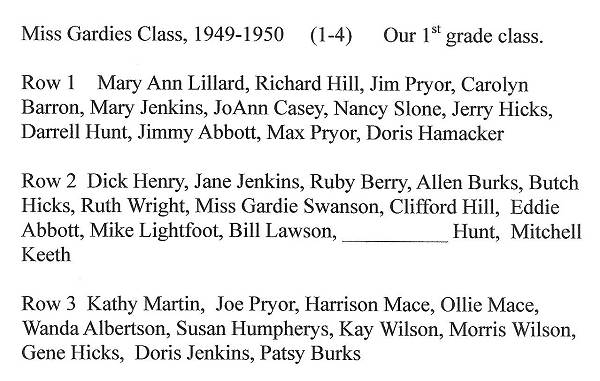
68 1961 Graduates 1st-4th Grades Names
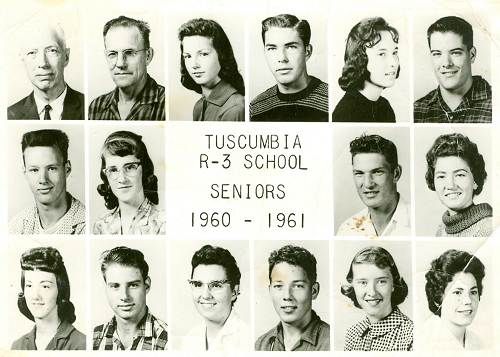
69 1961 Senior Class
Click image for larger view
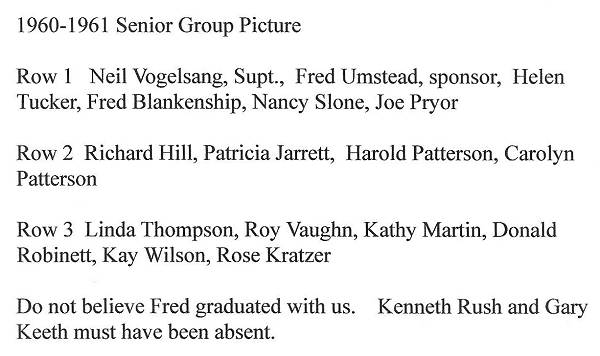
70 1961 Senior Class Names
In those early years first through fourth grades were in the same room with the same teacher. In addition, the original 1961 commencement program has been preserved and was available for viewing as well (photo 71).
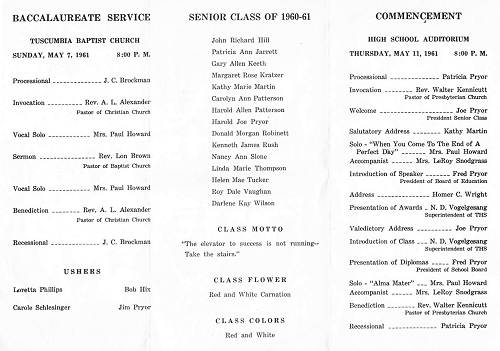
71 1961 Commnencement Program
Click image for larger view
All of us were greatly influenced by our first teacher, Miss Gardie Swanson, who taught at Tuscumbia for 39 years from 1919 to 1958. For many of us including myself she had taught our parents as well. Here is a clipping from the Autogram describing the day she was given an honorary retirement ceremony in 1958 (photo 72):
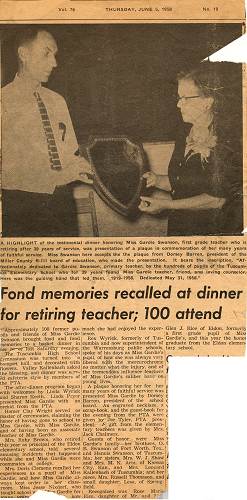
72 Gardie Swanson Retirement
Click image for larger view
I want to thank classmate Kathy Martin Fields for organizing the class preliminary meeting which was held at the museum. Especially, I want to recognize the time and effort she spent before hand contacting class mates, collecting photographs and class data for our meeting, and for providing drinks and snacks for us to enjoy.
Well, this week’s Progress Notes were mostly about me and my family. But I am grateful that I have enough roots here that I have something to write about whenever “writer’s block” makes its unwanted appearance!
That’s all for this week.
 Joe Pryor
Previous article links are in a dropdown menu at the top of all of the pages.
|

